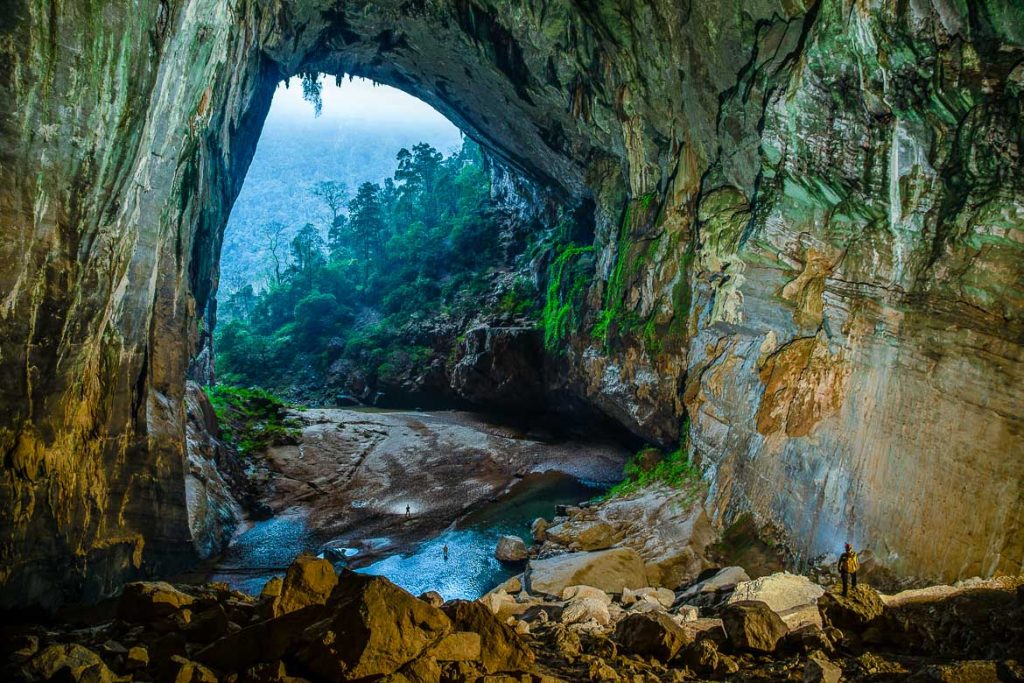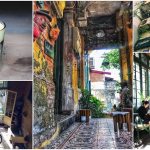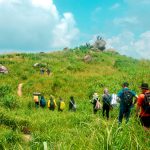The Son Doong experience is incredible beyond words.
It took us about a day to get to Son Doong, the largest cave in the world, which is located in the National Park of Phong Nha, Ke Bang, and Quang Binh province. Despite the fact that we were only able to visit one section of the cave, we were pleased and proud to be among the first Vietnamese amateur cavers to enter Son Doong.
The British Cave Research Association designated Son Dong Cave in National Park Phong Nha, Ke Bang (Quang Binh) as the world’s largest known cave passage on April 22, 2009.
Son Doong Cave, at 262-by-262 feet (80-by-80 meters) in most places, surpasses the previous world-record holder, Deer Cave in Malaysia’s Gunung Mulu National Park. After one year, the scientists confirmed that Son Dong Cave is at least 8, 5 km long, 200 m high, even up to 250m
Hang En Cave

A heavy rain greeted us in Phong Nha, Ke Bang. The path through a dense and moist primitive forest was obscured by leaf strata that prevented sunlight from penetrating the ground. Everyone walked in silence, step by step, on the slick, muddy ground infested with terrestrial leeches. We arrived at the Rao Thuong stream after a 1.5-hour trek through the forest. The water flowed calmly during the dry season, and the rocks emerged in the current. The path along the stream was flatter and easier from here.

We continued walking for another half hour and came to Doong village, which has 6 Van Kieu ethnic minority households scattered throughout this secluded mountainous area. The children sitting on the thatched roof house stared at us strangely. We continued walking for 3.5 kilometers to En (swallow) Cave, our first night’s stay on the way to Son Doong. We walked through a banana, weed, gynura crepidioides, colocasia esculenta, and laportea forest. We had to cut down the wild bananas to find our way because they grew so densely. The morning rain brought cool air but turned the ground into sticky mud, preventing us from moving.

We continued walking until we came across the entrance to En Cave, which was hidden in the distance. The stream became crooked before disappearing inside the cave. While we were still getting used to the dark, a swarm of butterflies appeared, encircling the strange visitors as if we were in the Nederland of fairytale stories.
We continued our journey to Son Doong the next day after eating dinner and sleeping in tents inside the Cave. It was anticipated to be more difficult, but also more exciting. Indeed, on this day, we were able to explore two caves: En Cave, which has the largest entrance, and Son Doong, the world’s largest cave.
We went inside Hang En by following the stream, climbing the rock field, and passing through the smooth sand. We couldn’t count the number of times we waded through a stream in the middle of the cave before climbing up and down the walls. We were tired, struggling up a steep stone slope, when we noticed a brilliant light ahead. It was the entrance to En Cave, measuring 78 meters in height and 70 meters in width. Crowds of swallows flew up and down above the cave, singing cheerfully. People who made it to the entrance beneath became tiny black dots on the gleaming rocks in the sun.


Son Doong Discovery
The path to Son Doong became more difficult after Hang En, with dense forests and high, slick slopes. The streams became deeper, and the current grew stronger. We had to tread carefully as the rock cliff became narrower. Our large backpacks became entangled from time to time. The slopes were extremely steep, muddy, and slippery, with only a slender ladder to climb.

A photographer climbing in Hang Son Doong. (Photo by Carsten Peter/National Geographic/Getty Images)

We arrived at the cave entrance after two hours of navigating the sheer and sharp canyons. It was much smaller than we had anticipated. It was mossy, foggy, and gloomy. We descended the steep entrance after preparing ropes and flashlights. We were nervous as we took our first steps inside the world’s largest cave.



Under the dim light of a flashlight, the cave bed opened wide, revealing the massive stalactites. We heard the running water echoing more clearly and impatiently as we passed by a twist. It was a churning small stream with white foam obstructing the path. We had to cross the stream without a rope by holding hands and walking carefully on the slick big cobblestones in the middle of the river bed.
We were ecstatic after overcoming the first challenge because we were the first amateur explorers in Son Doong Cave. The dim and flickering light of headlamps was like fireflies, and it was enough to take our breath away as we gazed at Son Doong’s breathtaking scenery. Massive stalagmites ran for hundreds of kilometers from the cliff to the cave’s bottom. The small stalagmites resemble majestic mountains. While we were admiring this natural wonder, some voices yelled, “See Doline 1 already!” Doline 1 is the first collapsed ceiling where light enters the cave and was also our first stop on our first day in Son Doong.
Everyone rushed to the top when they noticed a blurred flickering spot in the distance. We came to a halt for 10 minutes when Doline 1 appeared clearly, and from above, we happily observed a magical stream of light plunging into the dark cave. A bank of smooth sand lies at the foot of Doline 1. The cave bed transforms into a vast endless slope with the majestically stone wall under the illuminated light from the deep pools to the ceiling (dozens of kilometers).
A half-mile block of 40-story buildings, according to National Geographic explorers, could fit inside this stretch of Hang Son Dong. We were hesitant to stop because there was no way to cross this extremely deep chasm. With a heavy heart, we resolved to buy more equipment, devices, and train to climb with bolts so that one day, we could return to Son Doong Cave and discover the rest.


















